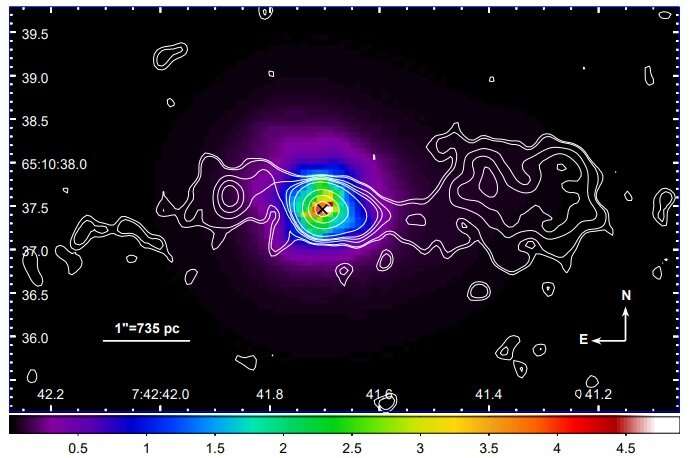May 9, 2022 report
Study reveals termination shocks and extended X-ray emission in the active galaxy Markarian 78

Using NASA's Chandra X-ray observatory, astronomers from the Harvard-Smithsonian Center for Astrophysics (CfA) and elsewhere have investigated an active galaxy known as Markarian 78. They report that the source exhibits termination shocks and extended X-ray emission. The study was detailed in a paper published April 27 on arXiv.org.
Active galactic nuclei (AGNs) are accreting, supermassive black holes residing at the centers of some galaxies, emitting powerful, high-energy radiation as they accrete gas and dust. These nuclei can form jets, having mostly cylindrical, conical or parabolic shapes, which are observed even on megaparsec scales. In general, galaxies hosting AGNs are called active galaxies.
At a distance of some 521 million light years away from the Earth, Markarian 78 (or Mrk 78 for short) is a Type II Seyfert galaxy with an estimated size of about 2,400 light years. Mid-infrared emission from this galaxy is dominated by AGN-heated dust and the intrinsic 2−10 keV luminosity of this source was measured to be between 8 and 12 tredecillion erg/s.
Previous observations of Mrk 78 found that its radio jet is deflected by the ionized gas that it encounters and accelerates it. Moreover, it was found that the radio jet is disrupted by a compact cloud and expands into a leaky "bubble," accelerating and ablating ionized gas knots.
In order to get a better view of physical mechanisms by which the central AGN impacts the gas in Mrk 78, a team of astronomers led by CfA's Francesca M. Fornasini conducted X-ray observations of this galaxy using Chandra's Advanced CCD Imaging Spectrometer (ACIS). The results were compared with previous radio studies of this source.
The researchers managed to image the inner region of Mrk 78 at sub-arcsecond resolution in X-rays and found a complex morphology with spectral variations on scales from 650 to 6,500 light years. Although the observations detected a compact (about 2,300 light years in diameter) knot of X-rays, on the Eastern side of the source, coincident with the radio knot, it turns out that its Western side is quite different as it is dominated by an extended loop of X-ray emission (about 5,500 light years from the nucleus and approximately 4,500 light years in diameter.
Furthermore, in the extended emission regions the astronomers identified complex spectra requiring at least two components, either photoionized or thermal, and possible intrinsic obscuration. It was noted that spectral fitting of this extended emission prefers models that include thermal models representative of shocked emission.
The scientists estimate that the thermal energy that may be injected into the interstellar medium by these termination shocks is between 200 and 600 duodecillion erg/s. Based on that, they calculated that the total power released by the shocks in these regions is estimated to be within the range of 200 and 2,000 duodecillion erg/s.
In general, the researchers noted that the shocks on the Western side of Mrk 78 occur around 3,260 light years farther out than on the Eastern side. They suppose that soft X-ray shocked emission closer to the nucleus is present but strongly absorbed, or that shocked gas closer to the nucleus may be too hot to cool rapidly. These two hypotheses, according to the authors of the paper, are the most plausible explanations for such an offset of the Western X-ray emission from the outflow turnover radius.
More information: Francesca M. Fornasini et al, Termination Shocks and the Extended X-ray Emission in Mrk 78. arXiv:2204.13140v1 [astro-ph.HE], arxiv.org/abs/2204.13140
© 2022 Science X Network





















